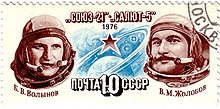Soyuz 21
| Mission dates | |||||||
|---|---|---|---|---|---|---|---|
| Mission: | Soyuz 21 | ||||||
| COSPAR-ID : | 1976-64A | ||||||
| Spacecraft: |
Soyuz 7K-T (GRAY index 11F615A8) serial number 41 |
||||||
| Dimensions: | 6800 kg | ||||||
| Launcher: | Soyuz U ( GRAY index 11A511U) | ||||||
| Call sign: | Байкал (Baikal - " Lake Baikal ") | ||||||
| Crew: | 2 | ||||||
| Begin: | July 6, 1976, 02:08:45 UTC | ||||||
| Starting place: | Baikonur 1/5 | ||||||
| Space station: | Salyut 5 | ||||||
| Coupling: | July 7, 1976, 13:40 UTC | ||||||
| Decoupling: | August 24, 1976, 3:12 pm UTC | ||||||
| Landing: | August 24, 1976, 18:32:17 UTC | ||||||
| Landing place: | 200 km southwest of Kokshetau | ||||||
| Flight duration: | 49d 6h 23m 32s | ||||||
| Earth orbits: | 790 | ||||||
| Rotation time : | 88.7 min | ||||||
| Apogee : | 253 km | ||||||
| Perigee : | 193 km | ||||||
| ◄ Before / After ► | |||||||
|
|||||||
Soyuz 21 is the mission name for the flight of a Soviet Soyuz spacecraft to the Soviet space station Salyut 5 (Almas 3), which started on July 6, 1976 . It was the first Soyuz spacecraft visit to this space station and the 38th flight in the Soviet Soyuz program.
crew
Main team
- Boris Walentinowitsch Wolynow (2nd space flight), commander
- Vitaly Michailowitsch Scholobow (1st space flight), flight engineer
Volynov and Sholobov already formed the substitute team for Soyuz 15 . However, due to the problems encountered, the Soyuz 16 flight was canceled and later operated with a different profile. Wolynow and Scholobow had to wait almost two years before they were used.
Substitute team
- Vyacheslav Dmitrievich Sudov (1st space flight), commander
- Valery Ilyich Roshdestvensky (1st space flight), flight engineer
The support team consisted of Anatoly Berezovoy , Yuri Glaskow , Viktor Gorbatko and Mikhail Lisun .
Mission overview
They were tests on a manned military space station. These included earth observations with hand spectrographs , earth recordings with various black-and-white and color films, infrared telescopes, communications outside the range of ground-based stations via a Molnija satellite and experiments for independent navigation of the station (astrometric). The visit to the space station took place at the same time as the Red Army's “Sibir” maneuver in Siberia . The cosmonauts observed the exercise as part of checking the station for military suitability. However, further basic studies on medical-biological questions of long space flights were investigated (studies on guppies , experiment "Levkoje" to measure heart volume, germination experiments with plants). There were also experiments on crystal development ( potash alum ) and solar observation. Since the flight length of previous expeditions was not reached, there is speculation about the reasons for the termination - poisonous gases or psychological problems (space sickness or homesickness for Vitaly Scholobow) may have played a role.
See also
Web links
- Soyuz 21 at spacefacts.de
- Soyuz 21 at space.kursknet.ru (English / Russian , archived 2016)
- Soyuz 21 in the Encyclopedia Astronautica (English)
- Soyuz 21 in the NSSDCA Master Catalog (English)

